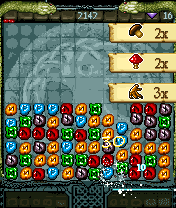
Witches have had a fairly mixed time in fantasy and fairytales. While used always to be warty old crones or shape changing sirens, nowadays they all seem to be about Mother Earth and healing the planet. Where’s the fun in that?
It’s good to see, then, that in Rune’s Quest you play the traditional witch, complete with crooked hat, black cat and cauldron. Although, much like its shape-changing cousin, not all is as it first appears.
The first impressions of Rune’s Quest are very positive. The game is bright, well animated and easy to play. Rather than make yet another match three game, InLogic has decided on a different classic format in which any two or more matching colours can be removed. While at first this appears far too easy, once more colours are added to the board the difficulty ramps up satisfyingly.
Throw in power-ups, a lengthy Story mode, five other game types, and online leaderboards, and Rune’s Quest looks more like a beautiful, young white witch than the old crone you apparently control.
A little while later, though, the warts begin to surface.
It all starts with the menus themselves. They're not very helpful, neatly missing out key controls in the sparse 'help' screen like ‘rotate puzzle’ and ‘use special power’. It doesn’t tell you how these powers work, either, relying on blind trial and error on the player’s part.
Bizarrely, the menus also reverse the normal way of continuing a puzzle, which will catch out impatient gamers used to pressing the left soft-key to load a saved game.
Likewise, the smoothly animated glowing cursor is very pretty, but also sluggish and slow. This causes far too many missed selections and puts the player under unnecessary pressure when the speed increases.
Much like a juicy red apple offered by a mysterious old lady, Rune’s Quest looks juicy, well polished and initially tastes great. A few bites, however, reveal a slightly disappointing aftertaste.
Rune's Quest Review

